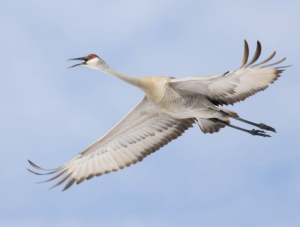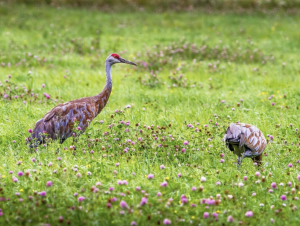
By Tausif Samin
On January 28, 2025, the Dyer Observatory staff dropped everything and ran outside when they heard the unmistakable calls of Sandhill Cranes overhead. Their loud, trumpet-like cries echoed across the sky—a sure sign that the annual winter migration was in full swing. With their wide wings, long legs, and effortless flight, these birds put on a show like no other, soaring in graceful formations against the crisp winter sky.
Sandhill Cranes are true survivors, with a history dating back over 2.5 million years. Every year, they travel incredible distances, covering thousands of miles between their breeding grounds in the northern U.S. and Canada and their wintering sites in the southeastern U.S. and beyond. Middle Tennessee is a key stop on their epic journey, providing vital wetlands and fields where they can rest and refuel. For birdwatchers and nature lovers, their arrival is a much-anticipated spectacle, a reminder of the rhythms of nature that have persisted for millennia.
Migration Through Middle Tennessee
Every year, from late October through February, thousands of Sandhill Cranes migrate through Middle Tennessee, heading south from their breeding grounds in the northern U.S. and Canada. Their destination? Warmer wintering sites in Tennessee, Florida, Texas, and the Gulf Coast.
One of the best places to witness this migration is the Hiwassee Wildlife Refuge near Birchwood, Tennessee. This area is a key wintering ground, where large flocks of cranes gather in impressive numbers. Peak migration occurs in January, making it the ideal time to observe these majestic birds.
Where to See Them

- Dyer Observatory, Nashville – Overhead flyovers during migration.
- Hiwassee Wildlife Refuge, TN – A major wintering stop.
- Wheeler National Wildlife Refuge, AL – Thousands of cranes gather here annually.

Between December 31, 2024, and January 30, 2025, numerous sightings of Sandhill Cranes have been reported in central Nashville. The orange markers on the map highlight recent observations near Vanderbilt University, East Nashville, Inglewood, and areas south of Berry Hill.
The Sandhill Crane Finder provides an interactive map of recent sightings across North America for those interested in tracking Sandhill Crane movements beyond Nashville. You can find more information on sightings here: https://sandhillfinder.savingcranes.org
Cool Facts About Sandhill Cranes

- Sandhill Cranes have some of the most distinctive calls in the bird world—a deep, rolling trumpet sound that can carry for miles. Their secret? A long, coiled trachea (windpipe) that gives their voices a rich, resonant quality. If you’ve ever heard them, you know how unforgettable that sound is!
- These cranes are also incredible dancers. They spread their wings, bow, leap, and pump their heads in an energetic display that looks like something out of a carefully choreographed performance. And it’s not just about romance—young cranes practice their moves, and even adults join in just for fun outside of mating season.
- Sandhill Cranes have been around for an astonishingly long time. A 2.5-million-year-old fossil found in Florida is nearly identical to today’s cranes, proving that their design has stood the test of time. When you see one, you’re looking at a living piece of ancient history!
- When it comes to relationships, these birds are truly devoted. Sandhill Cranes mate for life, forming strong bonds that can last over two decades. Both parents share the work of raising their young, and their chicks stick around for about 9–10 months before venturing out on their own.
- Speaking of chicks, these little ones are born tough. Within just eight hours of hatching, they’re up and moving—and even capable of swimming if they need to!
- And if you thought cranes had short lifespans, think again. The oldest recorded Sandhill Crane lived to be 37 years and 3 months old! This long-lived bird was first banded in Florida in 1982 and was later spotted in Wisconsin in 2019, proving that these birds are not only graceful but also built to last.

Finding Sandhill Cranes in the Wild
Want to see Sandhill Cranes in their natural habitat? Here’s how to boost your chances of spotting these elegant birds:
- Check Open Wetlands & Fields – Sandhill Cranes love grasslands, marshes, and prairies. They’re often found wading in shallow waters or foraging in open fields, so keep an eye on these landscapes.
- Listen for Their Calls – Their deep, bugling calls can carry for miles. If you hear their signature trumpeting sound, you’re likely close to a group of cranes.
- Visit Major Stopover Sites – Certain wildlife refuges attract thousands of cranes each year. Hiwassee Wildlife Refuge in Tennessee and Bosque del Apache in New Mexico are two prime locations where you can see massive flocks in the winter months.
- Watch the Skies During Migration – Look up! Sandhill Cranes fly in high, graceful V-formations, sometimes mixed with geese. Their long necks, broad wings, and distinctive flight patterns make them easy to recognize as they travel.
With a little patience and the right timing, you’ll be treated to one of nature’s most spectacular birdwatching experiences!